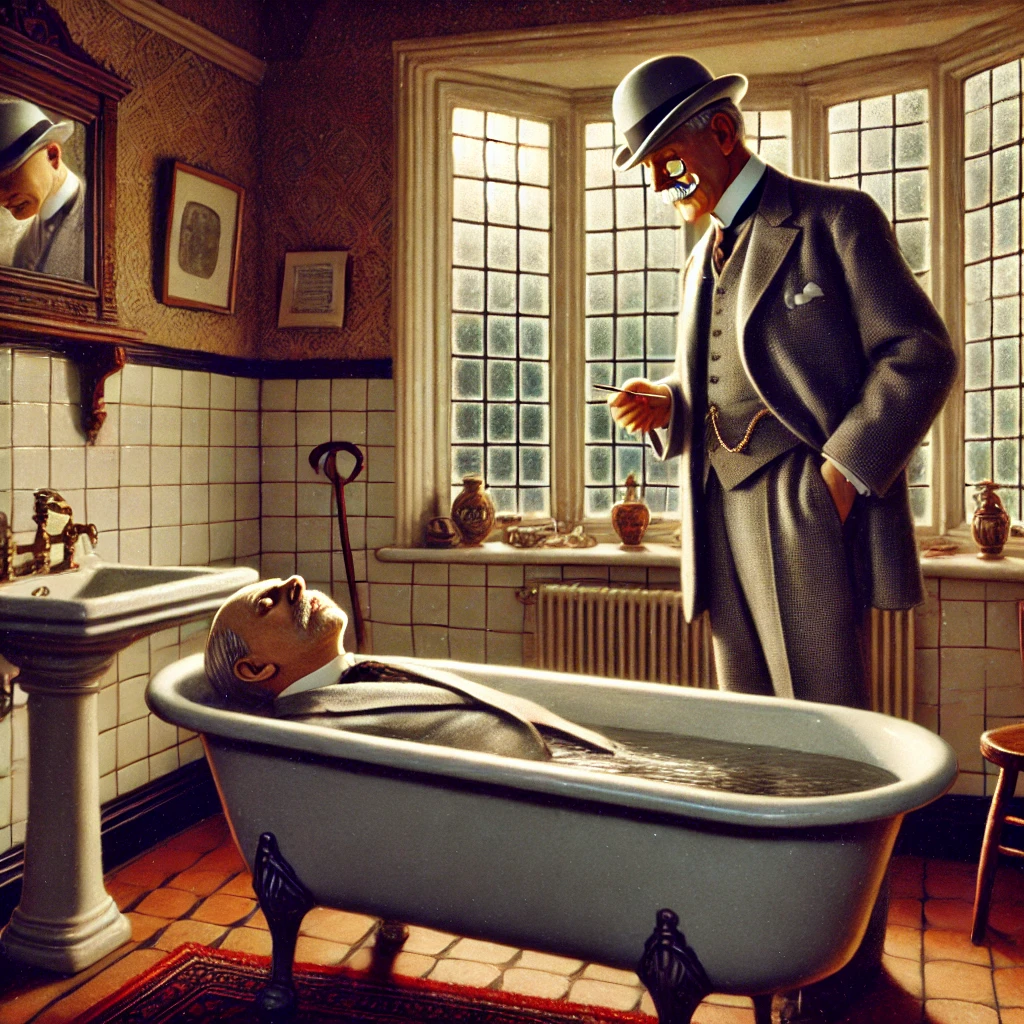The Teeth of the Tiger, written by Maurice Leblanc and first published in 1914, is one of the many adventures of Arsène Lupin, the gentleman-thief-turned-detective. In this novel, Lupin, under the alias Don Luis Perenna, finds himself entangled in a murder mystery involving a colossal inheritance, secret heirs, and a mysterious criminal plot. The novel blends action, intrigue, and intellectual puzzles, showcasing Lupin’s exceptional wit and detective skills.
Plot Summary
The day was ordinary in the office of the Prefect of Police. The secretary had just organized a few reports when Inspector Vérot staggered in, pale and shaking. It was unlike the burly, energetic officer, whose face usually radiated confidence. He spoke in cryptic terms about a crime that had already happened and two murders that would inevitably occur that very night. His voice trembled as he handed over a letter and a small box, urging the secretary to deliver them directly to the Prefect. But before he could say more, Vérot collapsed, visibly weakened, and disappeared shortly afterward, leaving everyone in a state of unease.
When the Prefect returned to his office, he found Vérot’s letter—a blank sheet of paper. Troubled by this oddity, he opened the small box left behind by the inspector, revealing something even stranger: a piece of chocolate with bite marks. It was a curious clue, but it wasn’t until they searched the office that the full tragedy came to light. Vérot was found in the Prefect’s dressing room, barely alive, mumbling incoherently about “the teeth.” His ominous last words hinted at the looming danger, but before they could make sense of his warnings, he died.
With Vérot’s cryptic clues swirling in their minds, the Prefect’s attention turned to a pressing matter: the inheritance of Cosmo Mornington, a recently deceased American millionaire who had left a fortune of 100 million francs. The will was clear: the fortune was to go to the heirs of his mother’s family, the Roussels, but if no heirs were found within three months, the entire sum would pass to a certain Don Luis Perenna, the executor of the will and Mornington’s close friend. This condition set the stage for a complex and dangerous game, one that attracted the attention of both the police and sinister forces working in the shadows.
Don Luis Perenna, a man of mystery and charm, soon became the focal point of the investigation. Known for his heroism in the Foreign Legion, he had saved Mornington’s life on more than one occasion. But beneath his composed exterior, he concealed a deeper identity—that of the legendary Arsène Lupin, the master of disguise and brilliant criminal mind turned detective. Perenna was drawn into the case not for the inheritance, but because his friend’s life had been cut short in a suspicious manner. He suspected that Mornington had been murdered, not by accident as was officially declared, but by foul play.
With time running out, Perenna found himself investigating two mysteries simultaneously: the location of the Roussel heirs and the threat of imminent murders. He worked closely with the Prefect, who gave him reluctant approval to pursue the case. As the investigation progressed, the police uncovered a shocking letter from Hippolyte Fauville, a civil engineer, who warned that both he and his young son were in mortal danger. Fauville claimed he had discovered proof of a deadly conspiracy and promised to bring it to the Prefect by morning. The letter intensified the search, but before they could act, Fauville himself arrived, visibly shaken and desperate, confirming the threat against him.
Fauville’s words were scattered and disjointed, but his terror was real. He spoke of an abominable plot and insisted he had found the necessary evidence to stop it. Yet his behavior only added to the mystery. He seemed unsure whether the danger would strike that night or the following day. Despite his condition, he refused police protection, leaving Perenna and the authorities scrambling to prevent the impending catastrophe.
Perenna’s investigation took him to the Café du Pont-Neuf, where Inspector Vérot had been just before his death. There, a critical detail emerged: Vérot had been writing a letter when another man at a nearby table had switched envelopes, leaving Vérot with a blank letter and taking his incriminating report. The man, described as tall, with a red beard and an eyeglass, had vanished. It was clear now—Vérot had been silenced before he could reveal the truth.
Back at the Prefect’s office, Perenna received another blow: the mysterious “teeth” that Vérot had mentioned were none other than the marks of a unique set of teeth found on the chocolate. The connection between the chocolate, the missing report, and the upcoming murders became clearer. Yet, without knowing the identity of the real culprits, Perenna could only act on instinct. He insisted on staying near Fauville’s house that night, convinced that the engineer and his son would be the next victims.
As night fell, a sense of dread settled over the city. Perenna kept watch, his keen mind calculating the next moves of the unseen enemy. But tragedy struck before he could intervene. The next morning, Hippolyte Fauville was found dead, and his young son lay lifeless beside him. Both had been poisoned, the very fate Vérot had tried to prevent. The mastermind behind the plot had struck again, leaving no trace behind.
Perenna’s mind raced through the tangled web of clues. He had lost two lives, but the game was far from over. Someone—likely connected to the Mornington inheritance—was eliminating the Roussel heirs one by one. And if no one could be found, the fortune would fall to Perenna. The stakes were higher than ever, not just for the money, but for the justice Perenna sought in avenging his friend’s death.
With the police now fully on his side, Perenna resolved to hunt down the killers. He was no longer merely a detective solving a crime—he was a man on a mission, determined to unravel the twisted conspiracy that bound the fates of so many. The game had begun, and Don Luis Perenna, the man who once bore the name of Arsène Lupin, was ready to play it to the end.
Main Characters
- Arsène Lupin (Don Luis Perenna): The protagonist of the story, Lupin is a brilliant and charismatic master of disguise and deduction. He assumes the identity of Don Luis Perenna, a war hero, to protect himself while solving a complex case. His sharp intellect and deep sense of justice drive the narrative as he seeks to uncover a deadly conspiracy.
- Inspector Vérot: A dedicated and experienced police officer, Inspector Vérot initiates the mystery by uncovering clues related to a sinister plot. He appears visibly distressed and warns of an impending crime before succumbing to a suspicious death.
- M. Desmalions: The Prefect of Police, he is a capable and respected authority figure who becomes instrumental in investigating the unfolding mysteries alongside Lupin. He respects Lupin’s insights, despite initial suspicions.
- Hippolyte Fauville: A civil engineer and one of the key figures in the mystery. He appears fearful for his life due to a secret plot he believes targets both him and his son.
- Cosmo Mornington: A wealthy American whose death triggers the entire plot. His vast fortune, bequeathed under mysterious conditions, sets the stage for the story’s intrigue.
Theme
Identity and Deception: Central to the story is the question of identity. Lupin’s multiple disguises and secret aliases reflect the novel’s exploration of how appearances can deceive. This theme is not limited to Lupin alone, as other characters also hide their true intentions, identities, or pasts.
Justice vs. Crime: The novel presents a constant battle between law enforcement and criminal masterminds. Lupin, who operates on the border between legal and illegal, becomes a symbol of vigilante justice, often outsmarting the authorities while pursuing his own sense of moral righteousness.
Wealth and Power: The vast Mornington inheritance is not only a plot driver but also represents the corrupting influence of wealth. Many characters’ motivations are tied to the pursuit of money, and the theme of greed is recurrent throughout the story.
Death and Fate: The novel presents death as a looming presence, especially with the premonitions of violence and murder. Characters like Hippolyte Fauville feel trapped by a destiny they cannot escape, emphasizing the theme of fatalism.
Writing Style and Tone
Maurice Leblanc’s writing in The Teeth of the Tiger is fast-paced and filled with sharp dialogue, reflecting the intellectual prowess and agility of Arsène Lupin. The prose is direct, keeping the action brisk and maintaining an air of suspense throughout. Leblanc’s style seamlessly combines elements of detective fiction with adventure, making the narrative as much about solving puzzles as it is about thrilling escapades.
The tone of the novel is often one of tension and intrigue, as the reader is constantly kept on edge, wondering what twists and turns the plot will take next. While the tension is palpable, Leblanc also injects humor and wit, particularly through Lupin’s character, making the novel not just a mystery but also a commentary on social norms and human nature.
We hope this summary has sparked your interest and would appreciate you following Celsius 233 on social media:
There’s a treasure trove of other fascinating book summaries waiting for you. Check out our collection of stories that inspire, thrill, and provoke thought, just like this one by checking out the Book Shelf or the Library
Remember, while our summaries capture the essence, they can never replace the full experience of reading the book. If this summary intrigued you, consider diving into the complete story – buy the book and immerse yourself in the author’s original work.
If you want to request a book summary, click here.
When Saurabh is not working/watching football/reading books/traveling, you can reach him via Twitter/X, LinkedIn, or Threads
Restart reading!








